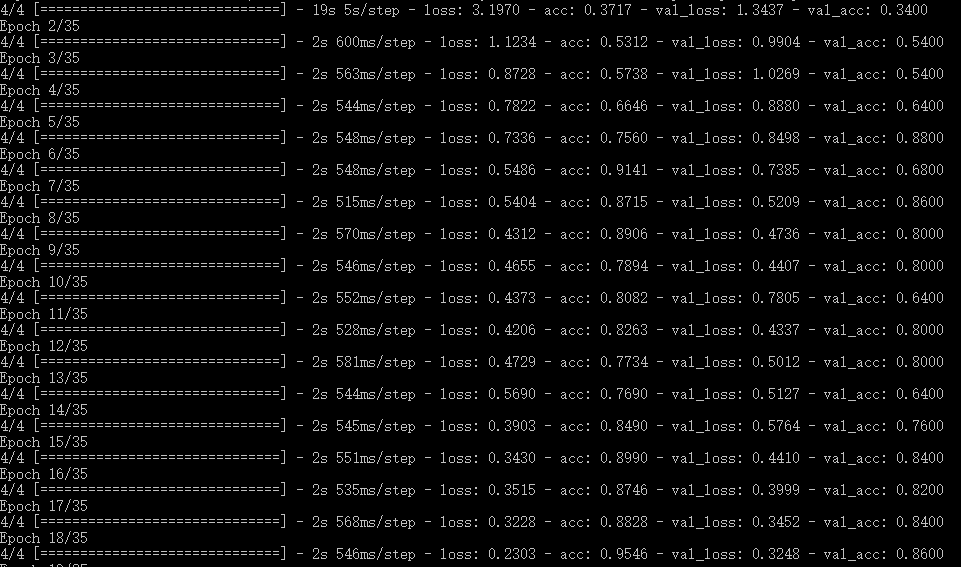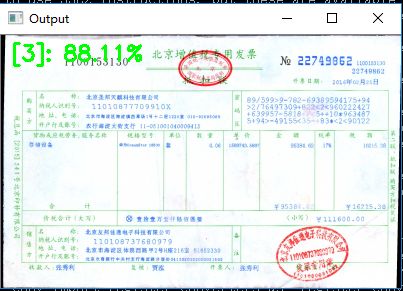特别感谢冠军的试炼博主,文章代码全来自于该博主的无私分享
原文链接
https://www.cnblogs.com/skyfsm/p/8051705.html
我做的仅仅是做了一下数据增强,补充匮乏的数据集
数据增强部分可参看我的上一篇博文
详细部分请去原作者文章处。
废话不多说,直接上代码:
训练代码:
# set the matplotlib backend so figures can be saved in the background
import matplotlib
matplotlib.use("Agg")
# import the necessary packages
from keras.preprocessing.image import ImageDataGenerator
from keras.optimizers import Adam
from sklearn.model_selection import train_test_split
from keras.preprocessing.image import img_to_array
from keras.utils import to_categorical
from imutils import paths
import matplotlib.pyplot as plt
import numpy as np
import argparse
import random
import cv2
import os
import sys
sys.path.append('..')
from net.lenet import LeNet
def args_parse():
# construct the argument parse and parse the arguments
ap = argparse.ArgumentParser()
ap.add_argument("-d", "--dataset", required=True,
help="path to input dataset")
ap.add_argument("-m", "--model", required=True,
help="path to output model")
ap.add_argument("-p", "--plot", type=str, default="plot.png",
help="path to output accuracy/loss plot")
args = vars(ap.parse_args())
return args
args = args_parse()
# initialize the number of epochs to train for, initial learning rate,
# and batch size
EPOCHS = 35
INIT_LR = 1e-3
BS = 32
CLASS_NUM = 4
norm_size = 64
# initialize the data and labels
def load_data2(path):
print("[INFO] loading images...")
data = []
labels = []
# grab the image paths and randomly shuffle them
imagePaths = sorted(list(paths.list_images(path)))
random.seed(42)
random.shuffle(imagePaths)
# loop over the input images
for imagePath in imagePaths:
# load the image, pre-process it, and store it in the data list
image = cv2.imread(imagePath)
image = cv2.resize(image, (norm_size, norm_size))
image = img_to_array(image)
data.append(image)
# extract the class label from the image path and update the
# labels list
label = int(imagePath.split(os.path.sep)[-2])
labels.append(label)
# scale the raw pixel intensities to the range [0, 1]
data = np.array(data, dtype="float") / 255.0
labels = np.array(labels)
# partition the data into training and testing splits using 75% of
# the data for training and the remaining 25% for testing
(trainX, testX, trainY, testY) = train_test_split(data,
labels, test_size=0.25, random_state=42)
# convert the labels from integers to vectors
trainY = to_categorical(trainY, num_classes=CLASS_NUM)
testY = to_categorical(testY, num_classes=CLASS_NUM)
return trainX,trainY,testX,testY
def load_data(path):
print("[INFO] loading images...")
data = []
labels = []
# grab the image paths and randomly shuffle them
imagePaths = sorted(list(paths.list_images(path)))
random.seed(42)
random.shuffle(imagePaths)
# loop over the input images
for imagePath in imagePaths:
# load the image, pre-process it, and store it in the data list
image = cv2.imread(imagePath)
image = cv2.resize(image, (norm_size, norm_size))
image = img_to_array(image)
data.append(image)
# extract the class label from the image path and update the
# labels list
label = int(imagePath.split(os.path.sep)[-2])
labels.append(label)
# scale the raw pixel intensities to the range [0, 1]
data = np.array(data, dtype="float") / 255.0
labels = np.array(labels)
# convert the labels from integers to vectors
labels = to_categorical(labels, num_classes=CLASS_NUM)
return data,labels
def train(aug,trainX,trainY,testX,testY,args):
# initialize the model
print("[INFO] compiling model...")
model = LeNet.build(width=norm_size, height=norm_size, depth=3, classes=CLASS_NUM)
opt = Adam(lr=INIT_LR, decay=INIT_LR / EPOCHS)
model.compile(loss="categorical_crossentropy", optimizer=opt,
metrics=["accuracy"])
# train the network
print("[INFO] training network...")
H = model.fit_generator(aug.flow(trainX, trainY, batch_size=BS),
validation_data=(testX, testY), steps_per_epoch=len(trainX) // BS,
epochs=EPOCHS, verbose=1)
# save the model to disk
print("[INFO] serializing network...")
model.save(args["model"])
# plot the training loss and accuracy
plt.style.use("ggplot")
plt.figure()
N = EPOCHS
plt.plot(np.arange(0, N), H.history["loss"], label="train_loss")
plt.plot(np.arange(0, N), H.history["val_loss"], label="val_loss")
plt.plot(np.arange(0, N), H.history["acc"], label="train_acc")
plt.plot(np.arange(0, N), H.history["val_acc"], label="val_acc")
plt.title("Training Loss and Accuracy on Invoice classifier")
plt.xlabel("Epoch #")
plt.ylabel("Loss/Accuracy")
plt.legend(loc="lower left")
plt.savefig(args["plot"])
#python train.py --dataset ../../invoice_all/train --model invoice.model
if __name__=='__main__':
args = args_parse()
file_path = args["dataset"]
trainX,trainY,testX,testY = load_data2(file_path)
# construct the image generator for data augmentation
aug = ImageDataGenerator(rotation_range=30, width_shift_range=0.1,
height_shift_range=0.1, shear_range=0.2, zoom_range=0.2,
horizontal_flip=True, fill_mode="nearest")
train(aug,trainX,trainY,testX,testY,args)
注意修改其中的CLASS_NUM为你的类别数
我这里仅仅只有四类,所以该值是4
关键代码:lenet.py
# import the necessary packages
from keras.models import Sequential
from keras.layers.convolutional import Conv2D
from keras.layers.convolutional import MaxPooling2D
from keras.layers.core import Activation
from keras.layers.core import Flatten
from keras.layers.core import Dense
from keras import backend as K
class LeNet:
@staticmethod
def build(width, height, depth, classes):
# initialize the model
model = Sequential()
inputShape = (height, width, depth)
# if we are using "channels last", update the input shape
if K.image_data_format() == "channels_first": #for tensorflow
inputShape = (depth, height, width)
# first set of CONV => RELU => POOL layers
model.add(Conv2D(20, (5, 5),padding="same",input_shape=inputShape))
model.add(Activation("relu"))
model.add(MaxPooling2D(pool_size=(2, 2), strides=(2, 2)))
#second set of CONV => RELU => POOL layers
model.add(Conv2D(50, (5, 5), padding="same"))
model.add(Activation("relu"))
model.add(MaxPooling2D(pool_size=(2, 2), strides=(2, 2)))
# first (and only) set of FC => RELU layers
model.add(Flatten())
model.add(Dense(500))
model.add(Activation("relu"))
# softmax classifier
model.add(Dense(classes))
model.add(Activation("softmax"))
# return the constructed network architecture
return model
另外训练的时候注意相对路径的问题,我这里刚开始报错就是相对路径写的不对,导致读取出错。
我这里的训练指令如下:
python train.py --dataset ./train --model invoice.model
训练过程如下:
可以看出准确率迭代还是很好的。总共就全集迭代35次。
最后生成了下面所示的invoice.model文件,就是我们的权重文件了
测试代码
# import the necessary packages
from keras.preprocessing.image import img_to_array
from keras.models import load_model
import numpy as np
import argparse
import imutils
import cv2
norm_size = 64
def args_parse():
# construct the argument parse and parse the arguments
ap = argparse.ArgumentParser()
ap.add_argument("-m", "--model", required=True,
help="path to trained model model")
ap.add_argument("-i", "--image", required=True,
help="path to input image")
ap.add_argument("-s", "--show", action="store_true",
help="show predict image",default=False)
args = vars(ap.parse_args())
return args
def predict(args):
# load the trained convolutional neural network
print("[INFO] loading network...")
model = load_model(args["model"])
#load the image
image = cv2.imread(args["image"])
orig = image.copy()
# pre-process the image for classification
image = cv2.resize(image, (norm_size, norm_size))
image = image.astype("float") / 255.0
image = img_to_array(image)
image = np.expand_dims(image, axis=0)
# classify the input image
result = model.predict(image)[0]
#print (result.shape)
proba = np.max(result)
label = str(np.where(result==proba)[0])
label = "{}: {:.2f}%".format(label, proba * 100)
print(label)
if args['show']:
# draw the label on the image
output = imutils.resize(orig, width=400)
cv2.putText(output, label, (10, 25),cv2.FONT_HERSHEY_SIMPLEX,
0.7, (0, 255, 0), 2)
# show the output image
cv2.imshow("Output", output)
cv2.waitKey(0)
#python predict.py --model invoice.model -i ../10.jpg -s
if __name__ == '__main__':
args = args_parse()
predict(args)
效果如下:
预测正确,done!还是如开篇所说,详细学习请去看原作者文章!



